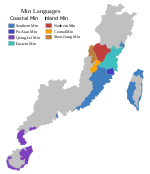lingvo.wikisort.org - Language
The Putian dialect (Pu-Xian Min: Pó-chéng-uā / 莆田話; IPA: [pʰɔu˩˩ lɛŋ˩˧ ua˩˩]) is a dialect of Pu-Xian Min Chinese spoken in urban area of Putian[further explanation needed], which is a prefecture-level city in the southeast coast of Fujian province.
| Putian | |
|---|---|
| Pó-chéng-uā / 莆田話 | |
| Native to | Southern China |
| Region | Putian, Fujian |
Language family | Sino-Tibetan
|
| Language codes | |
| ISO 639-3 | – |
| Glottolog | puti1238 |
| Linguasphere | 79-AAA-idb |
| Putian dialect | |||||||||||
|---|---|---|---|---|---|---|---|---|---|---|---|
| Traditional Chinese | 莆田話 | ||||||||||
| Simplified Chinese | 莆田话 | ||||||||||
| |||||||||||
Phonology
The Putian dialect has 15 initials, 40 rimes and 7 tones.
Initials
| Bilabial | Alveolar | Lateral | Velar | Glottal | ||
|---|---|---|---|---|---|---|
| Stop | Unaspirated voiceless | /p/ 巴 | /t/ 打 | /k/ 家 | /ʔ/ 烏 | |
| Aspirated voiceless | /pʰ/ 彭 | /tʰ/ 他 | /kʰ/ 卡 | |||
| Nasal | /m/ 麻 | /n/ 拿 | /ŋ/ 雅 | |||
| Fricative | Voiceless | /ɬ/ 沙 | /h/ 下 | |||
| Voiced | /β/* | /ɣ/* | ||||
| Affricate | Unaspirated voiceless | /ts/ 渣 | ||||
| Aspirated voiceless | /tsʰ/ 査 | |||||
| Approximant | /l/ 拉 | |||||
Rimes
| Open syllable | Nasal Coda /-ŋ/ | Glottal Coda /-ʔ/ | ||
|---|---|---|---|---|
| open mouth | a 鴉 | au 拗 | aŋ 江 | aʔ 壓 |
| ɒ 奥 | ɒŋ 王 | ɒʔ 屋 | ||
| o 科 | ɔu 烏 | ɔŋ 温 | ɔʔ 熨 | |
| e 裔 | ai 愛 | ɛŋ 煙 | ɛʔ 黑 | |
| ø 改 | œŋ 熊 | œʔ 郁 | ||
| ŋ 伓 | ||||
| even teeth | i 衣 | iu 油 | iŋ 引 | iʔ 益 |
| ia 夜 | iau 要 | iaŋ 鹽 | iaʔ 葉 | |
| closed mouth | u 夫 | ui 位 | uŋ 廣 | |
| ua 画 | uai 歪 | uaŋ 碗 | uaʔ 活 | |
| round mouth | y 余 | yŋ 恩 | yʔ 役 | |
| yɒ 安 | yɒŋ 羊 | yɒʔ 藥 | ||
Tones
| No. | 1 | 2 | 3 | 4 | 5 | 6 | 7 |
|---|---|---|---|---|---|---|---|
| Tones | dark level 陰平 |
light level 陽平 |
rising 上聲 |
dark departing 陰去 |
light departing 陽去 |
dark entering 陰入 |
light entering 陽入 |
| Tone contour | ˥˧˧ (533) | ˩˧ (13) | ˦˥˧ (453) | ˦˨ (42) | ˩ (11) | ʔ˨˩ (21ʔ) | ʔ˦ (4ʔ) |
| Example Hanzi | 詩巴 | 時爬 | 始把 | 試霸 | 寺罷 | 濕北 | 實拔 |
Assimilation
| Coda of the Former Syllable |
Initial of the Latter Syllable |
Assimilation | Coda of the Former Syllable |
Initial of the Latter Syllable | |
|---|---|---|---|---|---|
| Group A | Open syllable | /p/, /pʰ/ | → | remain unchanged | /β/, /ɣ/ |
| /t/, /tʰ/, /ts/, /tsʰ/, /ɬ/ | /l/ | ||||
| /k/, /kʰ/, /h/ | /ɣ/ | ||||
| /m/, /n/, /l/, /ŋ/, null initial | remain unchanged | ||||
| Group B | /-ŋ/ (nasal coda) | /p/, /pʰ/ | /-m/ | /m/ | |
| /t/, /tʰ/, /ts/, /tsʰ/, /l/, /ɬ/ | /-n/ | /n/, remain unchanged | |||
| /k/, /kʰ/, /h/, null initial | remain unchanged | /ŋ/ | |||
| /m/, /n/, /ŋ/ | /-m/, /-n/, /-ŋ/ | remain unchanged | |||
| Group C | /-ʔ/ (glottal Coda) | /p/, /pʰ/, /m/ | /-p̚/ | remain unchanged | |
| /t/, /tʰ/, /ts/, /tsʰ/, /ɬ/, /l/, /n/ | /-t̚/ | ||||
| /k/, /kʰ/, /ŋ/, /h/ | /-k̚/ | ||||
| null initial | /-ʔ/ | ||||
Tone sandhi
Putian dialect has extremely extensive tone sandhi rules: in an utterance, only the last syllable pronounced is not affected by the rules.
The two-syllable tonal sandhi rules are shown in the table below (the rows give the first syllable's original citation tone, while the columns give the citation tone of the second syllable):
| dark level 533 |
light level 13 |
rising 453 |
dark departing 42 |
light departing 11 |
dark entering ʔ21 |
light entering ʔ4 | |
| dark level 533 |
11 | 13 | 11 | ||||
| light level 13 |
11 | 55 | 42 | 11 | |||
| rising 453 |
13 | 11 | 13 | 11 | |||
| dark departing 42 |
55 | 42 | 55 | 42 | 55 | ||
| light departing 11 |
11 | 55 | 42 | 55 | |||
| dark entering ʔ21 |
ʔ4 | ||||||
| light entering ʔ4 |
ʔ21 | ||||||
References
- Compilation Commission of Chorography of Putian City 福建省莆田市地方志编纂委员会 (2001). Pu tian shi zhi 莆田市志 ["Chorography of Putian City"]. Vol. 43. Beijing: Fangzhi chubanshe 方志出版社 ["Chorography Press"]. ISBN 7-80122-669-0. Archived from the original on 2017-02-10. Retrieved 2018-04-06.
Текст в блоке "Читать" взят с сайта "Википедия" и доступен по лицензии Creative Commons Attribution-ShareAlike; в отдельных случаях могут действовать дополнительные условия.
Другой контент может иметь иную лицензию. Перед использованием материалов сайта WikiSort.org внимательно изучите правила лицензирования конкретных элементов наполнения сайта.
Другой контент может иметь иную лицензию. Перед использованием материалов сайта WikiSort.org внимательно изучите правила лицензирования конкретных элементов наполнения сайта.
2019-2025
WikiSort.org - проект по пересортировке и дополнению контента Википедии
WikiSort.org - проект по пересортировке и дополнению контента Википедии
